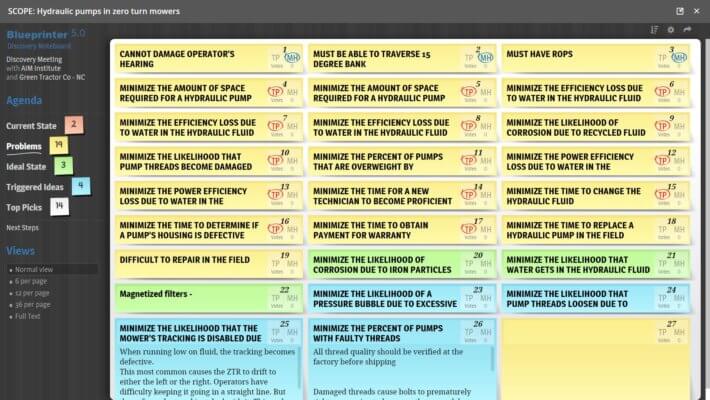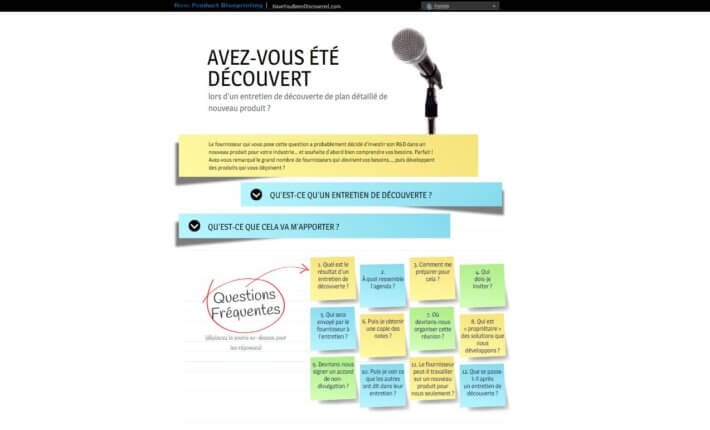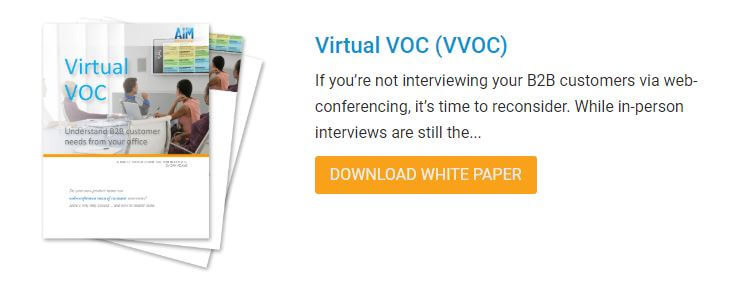What are Voice of the Customer Tools?

What are Voice of the Customer Tools? They boost the ability of innovators, product managers and marketers to execute Voice of the Customer. At a minimum, they are VoC collection tools. But beyond that, they should support the entire VoC process. That is, they help to select a market, execute qualitative and quantitative research, analyze data, and to communicate the results. Ultimately helping to create products, programmed for success. Before going too deeply, let’s consider a basic question. Why do we need tools anyway?
Tools provide leverage
Tools provide leverage. That is, they multiply our efforts. Archimedes pronounced, “Give me a lever long enough and a fulcrum to on which to place it, and I shall move the world.” There could hardly be a better illustration to speak to the meaning of “leverage” in the truest sense.
Therefore, in the mechanical world, the usefulness of tools is obvious. A carpenter would not be productive without a hammer or saw. A mechanic would not fix many cars without ratchets or screwdrivers. And in the modern age, these trades have even more sophisticated electronic tools than these. Whereas, decades ago, a carpenter would tap on a wall to determine the location of a stud. Today, they’d simply use an electronic stud-finder.
No need to belabor the point. Tools increase a person’s ability to accomplish a task.
Tools make everyone better! Better at what they’re trying to do. And part of the reason that a pro can outperform an amateur is the quality of their tools.

VOC Collection Tools, VOC Analysis Tools
When initially companies seek to improve their ability to gather customer insights, they commonly begin with training. But soon after, leaders realize that Word, PowerPoint, and Excel are not enough. They need VOC collection tools, to gather and house data. Also, they need VOC analysis tools, to efficiently analyze and study.
VOC collection tools? VOC analysis tools? Leading us to the broader question, “What are Voice of the Customer (VOC) tools?”

What are Voice of the Customer (VOC) Tools?
Voice of the Customer (VoC) tools are… tools! Just like with the hammer or screwdriver, or lever. They make the user better at what they’re trying to do. There are, of course, many Voice of the Customers tools for each stage of the process. There are VoC tools to select a market. To plan customer interviews. Afterwards, to execute qualitative interviews. To perform quantitative research along with data analysis. And finally, there are voice of the customer tools to help communicate the insights. VOC tools exist for each step.
AIM’s Tools within New Product Blueprinting
For example, consider some of the Voice of the Customer tools within AIM’s flagship methodology, New Product Blueprinting. There are simple ones, such as the “Have You Been Discovered Website.” This helps practitioners to execute one of the most time-consuming parts of any VOC process, recruiting customers. This interactive site, available in nine languages, answers any imaginable question that a customer might have. For example, “What’s in it for me?” or “Should we have a non-disclosure agreement?”

Next, we have the Discovery Interview Quick-Start Card. This is a moderator’s reference. Is it a crutch to facilitate an interview? Maybe! And that’s OK! Consider that pilots and doctors use the humble checklist to help with their normal duties. And so, we should embrace this simplicity for VOC.
How does the Discovery Interview Quick-Start Card help? It has an agenda, guides for probing, and tips for creating outcome statements. In one sense, a tool like this helps the moderator function at a higher level – because if their mind goes blank, they can just refer to the card. However, perhaps more importantly, it helps them to be confident (especially when learning these skills). There’s a measure of security in having this reference nearby. Secure and comfortable moderators will be relaxed. And ultimately, more effective in the pursuit to uncover more customer insights. This is the common theme for all Voice of the Customer Tools (including VOC collection tools and VOC analysis tools), greater effectiveness.

AIM’s Primary Voice of the Customer Tool: Blueprinter® software
Of course, at least from The AIM Institute, the crown jewel of voice of the customer (VoC) tools is Blueprinter® software. This tool manages all the steps of the customer insight process. Blueprinter software is the interface between the customer and the Blueprinting team for both qualitative and quantitative research. It safely and securely stores all customer data as a VoC collection tool. Blueprinter software has data analysis tools to turn up the magnification on sub-segments of a market. It generates reports that the Blueprinting team can share with management, or be used as a document for the next phase gate review. And when the project is completed, the team can make their data searchable by the entire company. This multiplies the impact of customer insight on real decisions, both in the present and the future.

Oh, and by the way, there’s this “little detail” about Blueprinter software: The Blueprinting team uses the “Discovery Noteboard” and the “Preference Noteboard” to facilitate Blueprinting sessions with customers. At a minimum, this ensures that the team accurately captures customer inputs. But there are many more benefits that we won’t get into here.
However, we shouldn’t forget that New Product Blueprinting is a B2B-optimized process. The Discovery Noteboard and Preference Noteboard ensure that customers have a great experience! As a result, the interview will improve that intangible yet critical quality that all B2B suppliers pursue, better customer relationships.
It’s time to employ Voice of the Customer Tools
It’s been said that nothing is more expensive than cheap tools. This is truer than ever with Voice of the Customer tools. Consider this. There are many ways of thinking about the idea of “value”. That is, the inherent worth that a thing has. One perspective is cost. Something is worth what one has paid for it.
Read AIM’s Article “The Amazing ROI for Voice of the Customer”
However, it’s possible that the “real worth” could be more than was paid. Or, it could be less. If you invest $10 in a share of stock, a year from now, it could be worth $8, $12, or the same $10. All investments are the same, in that you expect a return on the initial capital.
With Voice of the Customer tools, and in fact, with all Voice of the Customer investments, we likewise expect a return on capital. With great customer insight, we’ve increased the upside of all the investments that our company is already making. R&D? We’re already spending money there. Likewise, we’re spending on new product development and marketing. Customer insight increases the trajectory of what financial gains are possible. And it’s not just about increasing the upside. It’s also about limiting the downside. Without question, customer insight will reduce the likelihood of losses from new product flops. It maximizes the value of the portfolio.
The High Cost of the Cheapest Solution
Developing new products without customer insight is irresponsible. It’s poor stewardship to both the company’s shareholders and leadership. But that’s just the start. When products fail, companies fail. Time is lost, never to be recovered. When companies fail, factories are closed, and jobs are lost. Product failures are more than uncomfortable gate reviews. There’s a real human cost.
Quite frankly, the monetary cost of effective Voice of the Customer tools is negligible when you think about it. It’s of little consequence when compared to both the upside potential as well as the reduction in risk.
However, Voice of the Customer Tools are not enough
Imagine that you took one of your product managers and gave them Tiger Woods’ golf clubs. Would they become a scratch golfer? Hardly. In an even more ludicrous scenario, imagine that you gave them the scalpels and sutures of a heart surgeon. Would be qualified to perform a bypass surgery? Would you lie down on the operating table yourself? Doubtful!

Likewise, just giving all your employees professional Voice of the Customer tools, such as Blueprinter software, isn’t enough. They would not instantly become proficient. In fact, at The AIM Institute, we won’t even sell Voice of the Customer tools to those who haven’t been through one of our training programs.
Consider this, if you could only choose to either A) provide employees with Voice of the Customer training, or B) provide your companies with Voice of the Customer tools, which would you select? You’d choose the training. Training is more important. However, on the other hand, there’s no good reason to make this trade-off. Let’s go with both!
Pro golfers, heart surgeons and VoC practitioners all need training as well as the professional, up-to-date tools to perform at the highest level.
Add Web Conference Software to your Voice of the Customer Tool Set
VOC collection tools? VOC analysis tools? Sure. But don’t forget something at your disposal already. Your company already has web conference software. Put it to work! No better reason than the pursuit of customer insight. While in-person sessions are the best for interviews, there are actually some inherent advantages to conducting them virtually, via a web conference.
Advantages are obvious. You can do more in less time. And of course, can save on travel expenses as well. However, the quality of what you learn from customers can still be fantastic. And you can execute several Virtual VOC sessions in the time it would take to execute a single onsite version. In this article, Dan Adams explains the 10 Advantages along with seven tips for VVOC success. So, don’t forget this Voice of the Customer tool that you already have, your web conference software!

The Value of Voice of the Customer Tools
To understand the value of Voice of the Customer (VOC) Tools, we must first be convinced of the value of the customer’s voice! That is, of the value of customer insights to the company. How important is this? It’s the foundation of everything that The AIM Institute does.
The function can be distilled down to this: Innovation and new product development are problem-solving processes. And the first step to solving a problem? Is it to brainstorm solutions? NO. It’s to begin with a well-defined problem. The only nuance to innovation is that we’re solving a problem for a customer. Therefore, we need to understand their pain. We need to learn the root causes. And only afterwards, should we unleash our technical wizards.
Final Thoughts
To grow, a company must invest in customer insight. The first investment is time. Employees need time to study customers. Next, they need training, so that they can obtain relevant and unbiased data. They need process – to develop and validate products with customers. An execution strategy must be in place, absorbing the dynamics of the market.
And yes, they need tools. They need the best Voice of the Customer tools available. They need VOC collection tools as well as VOC analysis tools. Tools to define a market, to interview customers, to analyze data and to share insights internally.
Comments